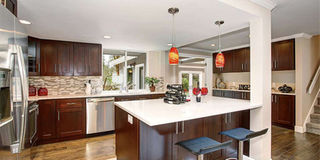A clean house keeps pests at bay

Keeping your kitchen countertops clean and storing leftover food in the refridgerator helps keep away cockroaches, ants and flies. PHOTO | FILE| NMG
What you need to know:
- For many people the first choice is pesticides and other chemicals. However, some of these products are suffocative and dangerous to humans, while others are ineffective because some pests have developed resistance to them.
- For outdoor lighting, place the light fixture away from doors, any entrances or openings into the house to ensure the insects they attract remain outside.
- Finally, ensure that whatever you bring to your house is clean since bedbugs can be transported by, say a bag or carton you use to carry things home. Indeed, many people get surprised when the bugs infest their homes, unaware that they unwittingly brought the eggs home.
After a frustrating search for a house in the city, Titus Simiyu found what the perfect apartment. It had two bedrooms and was affordable, so he moved in quickly.
What he did not know, however, was that his new neighbourhood was infested with pests; colonies of giant mice thrived in a dilapidated warehouse nearby and often sneaked into the apartments. And a bog next to the godowns harboured mosquitoes, and occasionally, snakes.
“I nearly had a heart attack one night when I stepped on one of those rodents as I was going up to my apartment. Its squeaks made me almost awaken the entire block with my yelling,” he says.
Pests are a nuisance because, besides causing distress, they can damage property and even transmit diseases.
So, how can you rid your residence of pests or keep them at bay?
For many people the first choice is pesticides and other chemicals. However, some of these products are suffocative and dangerous to humans, while others are ineffective because some pests have developed resistance to them.
In fact, experts recommend the use of pesticides only as the last resort and say they should be used sparingly. Better still, there are preventive measures that, if adhered to, will go a long way in ensuring your home remains pest-free.
DOS AND DONT’S
Experts list a number of dos and don’ts that you should observe to keep your home pest-free, as well as counter the adverse effects of infestation.
For a start, keep your surroundings clean; clear any bushes and dilapidated structures around the home, cover disused holes, ensure manholes are covered and, if possible, drain any fens and marshes near your home. Doing this lowers the chances of pests thriving in the neighbourhood, which might eventually lead to their eradication.
You can also use lighting: when tactically fixed, lights can control flying insects around doors and windows. So despite mercury vapour lights being more energy efficient, replacing them with high-pressure sodium vapour or halogen lights, as well as using bulbs with yellowish or orange tinges, deters night-time flying pests.
For outdoor lighting, place the light fixture away from doors, any entrances or openings into the house to ensure the insects they attract remain outside.
Doors and windows should always be in good condition or any cracks on them sealed to keep out pests, especially at night.
Investing in a door sweep to keep out crawling and slithering pests is also advisable.
Loose cladding, missing roof shingles and openings on utility lines such as drainage pipes and electric cable piping also give pests a chance to enter the house and should be covered. Screen meshes with at least 200 holes per square inch are ideal for covering these areas.
LITTER-FREE
Trash and litter in the patio or yard give the pests something to feed on. Backyards, decks, and particularly areas around the kitchen, should kept free of litter, weeds, dirt and stagnant water.
Trash cans should have tight-fitting covers and should be cleaned regularly to remove spills and food residues that might attract pests.
Drains, sinks, septic tanks and underfloor drainage systems often accrue gunk and debris, which attracts a variety of pests, particularly flies, by providing them with food and ideal breeding grounds. Ensure they are covered and that the muck and debris are removed.
Keep leftover food in sealable containers or containers with tight lids and store them in the refrigerator, if you have one.
Bedbugs have become a real menace in many homes and even institutions. They thrive in dirty and stuffy places, so it is important to air your sofa sets and bedding. Also, seal any cracks on your bed. Applying kerosene to the bed, especially in the spaces between the joints where the bugs live, also works.
Finally, ensure that whatever you bring to your house is clean since bedbugs can be transported by, say a bag or carton you use to carry things home. Indeed, many people get surprised when the bugs infest their homes, unaware that they unwittingly brought the eggs home.
Essentially, it all boils down to basic hygiene. The cleaner the home, the less likely it is to attract bugs.
However, in places like flats, your individual efforts might not be adequate, so you might have to seek expert help.





